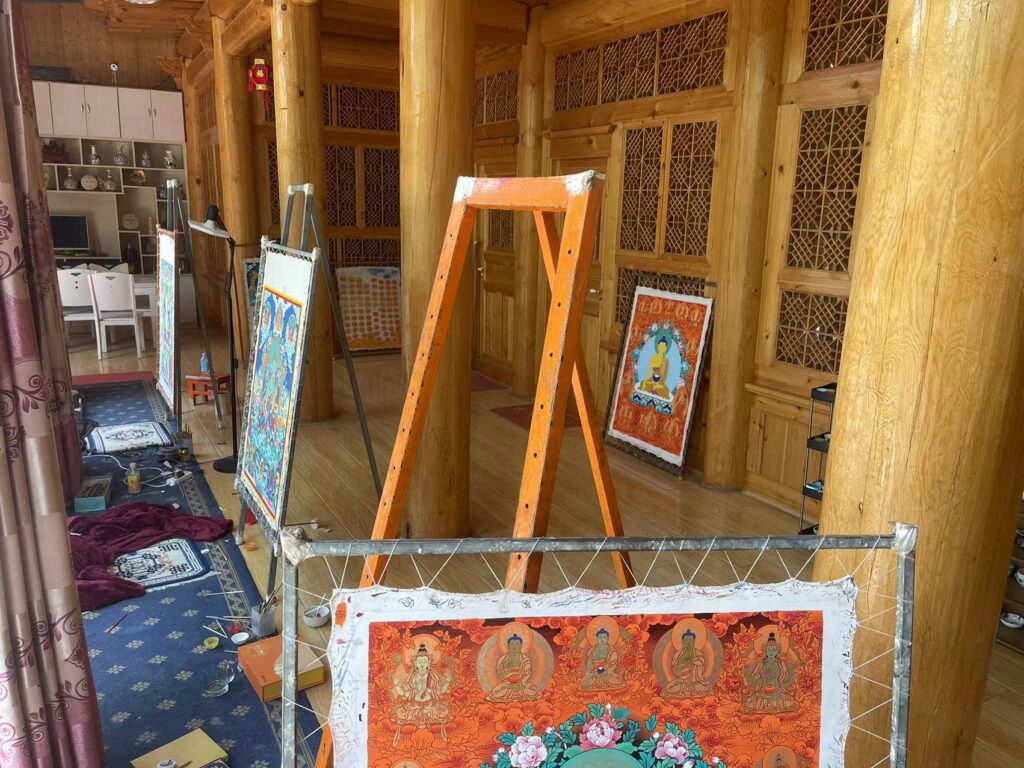
A thangka, also spelled as “tangka,” “thankga,” or “tanka,” is a traditional Tibetan Buddhist painting on cotton, silk appliqué, or paper, usually depicting a Buddhist deity, scene, or mandala. The word “thangka” means “recorded message” in Tibetan, reflecting its use as a teaching tool or visual aid in religious practice. Here are some key points about thangkas:
Characteristics and Uses
- Religious Art: Thangkas are primarily religious objects intended to serve as meditation tools and aids in spiritual practice. They are often hung in monasteries, temples, and private homes for devotional purposes.
- Depictions: Common subjects of thangkas include:
- Deities: Images of Buddhas, Bodhisattvas, and other divine beings.
- Scenes: Illustrations of significant events from the life of the Buddha, the lives of other Buddhist saints, or historical figures.
- Mandala: Geometric designs representing the universe, used in meditation practices.
- Materials and Techniques: Thangkas are made using various techniques, including painting with mineral and vegetable pigments, embroidery, and appliqué. The materials used are traditionally natural, ensuring longevity and vibrant colors.
- Portability: Thangkas are designed to be rolled up for easy transport, making them portable teaching tools for monks and practitioners who travel.
Symbolism and Importance
- Spiritual Significance: Thangkas are more than mere artworks; they are considered sacred objects imbued with spiritual power. Creating a thangka is often a meditative act in itself, and the process follows strict iconographic rules and rituals.
- Educational Role: Thangkas serve as visual aids to convey complex Buddhist teachings and narratives. They help practitioners visualize deities, which is an essential aspect of certain meditative practices.
- Cultural Heritage: Thangkas are an important part of Tibetan cultural heritage, reflecting the region’s religious, artistic, and historical traditions.
Viewing and Preservation
- Display: Thangkas are typically displayed during religious ceremonies and special occasions. When not in use, they are carefully rolled up and stored to protect them from damage.
- Conservation: Due to their sacred nature and historical value, thangkas are preserved with great care. Museums and collectors often undertake special conservation efforts to maintain their condition.
Summary
A thangka is a sacred Tibetan Buddhist painting or textile work of art that serves as a meditation aid and teaching tool. Rich in religious and cultural symbolism, thangkas depict deities, spiritual scenes, and mandalas, following precise iconographic guidelines. They hold profound spiritual significance and are carefully crafted and preserved as treasured elements of Tibetan heritage.
Rebkong Thangka
Rebkong, also known as Tongren in Chinese, is renowned for its unique and highly esteemed thangka art. Situated in the Huangnan Tibetan Autonomous Prefecture in Qinghai Province, China, Rebkong has a long history of producing exquisite thangkas, and it is considered one of the most important centers for Tibetan Buddhist art. Here’s an overview of Rebkong thangka and its significance:
Characteristics of Rebkong Thangka
- Distinctive Style: Rebkong thangkas are known for their intricate details, vibrant colors, and fine brushwork. The artists use natural mineral pigments, which give the paintings their characteristic luminosity and durability.
- Themes: Common themes include depictions of Buddhist deities, bodhisattvas, historical figures, mandalas, and scenes from Buddhist scriptures. Each thangka follows strict iconographic guidelines, ensuring religious accuracy and symbolic significance.
- Techniques: The creation of a Rebkong thangka involves several steps, including preparing the canvas, sketching the outline, applying colors, and adding intricate details. The process requires significant skill, patience, and devotion.
Cultural and Religious Significance
- Spiritual Practice: Thangkas are used as aids in meditation and visualization practices. They help practitioners focus their minds and connect with the depicted deities and symbols.
- Educational Tools: Thangkas serve as visual representations of complex Buddhist teachings and narratives, making them accessible to both monks and laypeople.
- Artistic Heritage: Rebkong thangka painting is a crucial part of Tibetan cultural heritage. The skills and techniques are often passed down through generations within families and monastic communities.
Rebkong as a Center of Thangka Art
- Training and Schools: Rebkong hosts several schools and workshops where aspiring artists learn the traditional techniques of thangka painting. These institutions play a vital role in preserving and promoting the art form.
- Festivals and Exhibitions: The region frequently holds festivals and exhibitions showcasing thangka art. These events attract visitors from around the world and help sustain the local economy.
- UNESCO Recognition: The thangka painting tradition of Rebkong has been recognized by UNESCO as an Intangible Cultural Heritage of Humanity, highlighting its global cultural significance.
 Tibet World Travel Tibet Tour, Tibet Trip, Tibet Travel, Tibet Train, Tibet Trekking,
Tibet World Travel Tibet Tour, Tibet Trip, Tibet Travel, Tibet Train, Tibet Trekking,
